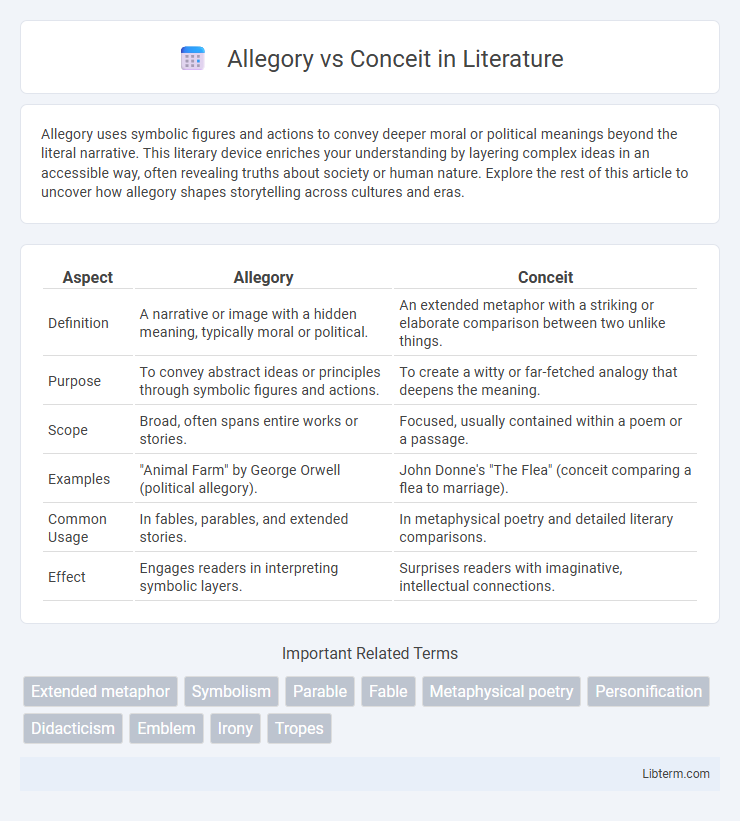Allegory uses symbolic figures and actions to convey deeper moral or political meanings beyond the literal narrative. This literary device enriches your understanding by layering complex ideas in an accessible way, often revealing truths about society or human nature. Explore the rest of this article to uncover how allegory shapes storytelling across cultures and eras.
Table of Comparison
| Aspect | Allegory | Conceit |
|---|---|---|
| Definition | A narrative or image with a hidden meaning, typically moral or political. | An extended metaphor with a striking or elaborate comparison between two unlike things. |
| Purpose | To convey abstract ideas or principles through symbolic figures and actions. | To create a witty or far-fetched analogy that deepens the meaning. |
| Scope | Broad, often spans entire works or stories. | Focused, usually contained within a poem or a passage. |
| Examples | "Animal Farm" by George Orwell (political allegory). | John Donne's "The Flea" (conceit comparing a flea to marriage). |
| Common Usage | In fables, parables, and extended stories. | In metaphysical poetry and detailed literary comparisons. |
| Effect | Engages readers in interpreting symbolic layers. | Surprises readers with imaginative, intellectual connections. |
Introduction to Allegory and Conceit
Allegory is an extended narrative or image that uses symbolic figures, actions, or events to convey complex ideas and moral lessons beyond the literal meaning. Conceit, often found in poetry, is a brief, elaborate metaphor that establishes a striking parallel between two seemingly unrelated things to provoke thought. Understanding the distinction highlights how allegory develops a comprehensive symbolic framework, while conceit concentrates on a focused, imaginative comparison.
Definitions: What is an Allegory?
An allegory is a literary device where characters, events, or settings symbolize abstract ideas or moral qualities, creating a layered narrative with deeper meanings beyond the literal story. It functions as an extended metaphor, often conveying complex messages about morality, politics, religion, or philosophy throughout the entire work. Famous examples include George Orwell's "Animal Farm," where the farm animals represent figures and events from the Russian Revolution.
Definitions: What is a Conceit?
A conceit is an extended metaphor that establishes a striking and elaborate comparison between two vastly different objects or ideas, often used in poetry to create unexpected connections. It typically involves clever and intellectual ingenuity, transforming ordinary things into symbolic and thought-provoking imagery. Conceits are central to metaphysical poetry, showcasing intricate and imaginative parallels that challenge the reader's perception.
Historical Origins and Development
Allegory originated in ancient Greek and Roman literature as a narrative technique where symbolic figures and actions convey complex moral or political meanings, famously used in works like Plato's "Allegory of the Cave." Conceit emerged during the Renaissance and peaked in the Metaphysical poetry of the 17th century, characterized by elaborate and intellectual metaphors that connect dissimilar ideas, exemplified by John Donne's poems. Both devices evolved to enrich literary expression, with allegory embedding overarching symbolic frameworks and conceit focusing on intricate, extended comparisons.
Key Features of Allegory
Allegory is characterized by its use of extended metaphors where characters, events, and settings symbolically represent abstract ideas or moral qualities, often conveying complex messages or lessons. It operates on two levels: the literal narrative and the deeper symbolic meaning, allowing for multiple interpretations rooted in cultural, political, or spiritual contexts. Key features include consistent symbolism throughout the text, a structured framework that reflects an overarching theme, and the aim to teach or illustrate philosophical, ethical, or social concepts.
Key Features of Conceit
Conceit is a highly elaborate and extended metaphor that establishes an intellectual and often surprising connection between two seemingly unrelated things, intensifying the emotional or thematic impact. Key features of conceit include its complexity, novelty, and the use of striking or unconventional comparisons that challenge readers' perceptions. Unlike allegory, which relies on a structured narrative with multiple symbols, conceit centers on a single, sustained comparison within a short passage or poem.
Major Differences Between Allegory and Conceit
Allegory is an extended narrative or image that represents abstract ideas and principles, often conveying moral, political, or spiritual meanings throughout an entire work, while conceit is a brief, clever, and elaborate metaphor that compares two seemingly unrelated things to create an intellectual or emotional effect. Allegories function on a broader, more comprehensive scale, integrating multiple elements to symbolize larger concepts, whereas conceits operate as focused poetic devices that highlight unique, imaginative comparisons within a limited scope. The primary difference lies in allegory's structural depth and didactic purpose contrasted with conceit's intricate, often surprising metaphorical ingenuity within poetry or prose.
Notable Examples in Literature
Allegory is exemplified by George Orwell's "Animal Farm," where animals symbolize political figures and ideologies, creating a layered narrative about totalitarianism. Conceit is famously illustrated in John Donne's "A Valediction: Forbidding Mourning," using an extended metaphor comparing lovers' souls to the two legs of a compass. These literary techniques deepen thematic complexity by embedding symbolic relationships within the text.
Literary Impact and Interpretation
Allegory employs extended symbolism to convey complex moral or political messages, allowing readers to interpret layered meanings within a structured narrative framework. Conceits create striking, often unconventional metaphors that challenge conventional thought, prompting deeper intellectual engagement through imaginative comparison. Both devices enhance literary impact by enriching thematic depth and encouraging varied interpretative perspectives.
Choosing Between Allegory and Conceit in Writing
Choosing between allegory and conceit in writing depends on the desired depth and complexity of symbolism; allegory offers an extended narrative with multiple layers of meaning, guiding readers through a structured metaphorical framework. Conceits focus on a single, often surprising or elaborate comparison that highlights a particular idea or theme in a concise and impactful way. Writers seeking broad thematic exploration may prefer allegory, while those aiming for sharp, inventive imagery might opt for conceit.
Allegory Infographic

 libterm.com
libterm.com